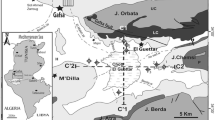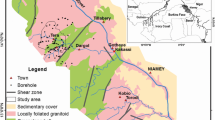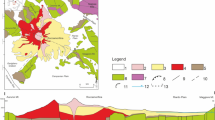Abstract
Environmental isotope techniques, hydrogeochemical analysis and hydraulic data are employed to identify the main recharge areas of the Mt. Vulture hydrogeological basin, one of the most important aquifers of southern Italy. The groundwaters are derived from seepage of rainwater, flowing from the highest to the lowest elevations through the shallow volcanic weathered host-rock fracture zones. Samples of shallow and deep groundwater were collected at 48 locations with elevations ranging from 352 to 1,100 m above sea level (a.s.l.), for stable isotope (δ18O, δD) and major ion analyses. A complete dataset of available hydraulic information has been integrated with measurements carried out in the present study. Inferred recharge elevations, estimated on the basis of the local vertical isotopic gradient of δ18O, range between 550 and 1,200 m a.s.l. The isotope pattern of the Quaternary aquifer reflects the spatial separation of different recharge sources. Knowledge of the local hydrogeological setting was the starting point for a detailed hydrogeochemical and isotopic study to define the recharge and discharge patterns identifying the groundwater flow pathways of the Mt. Vulture basin. The integration of all the data allowed for the tracing of the groundwater flows of the Mt. Vulture basin.
Résumé
Des techniques isotopiques environnementales, analyse hydrogéochimique et données hydrauliques ont été employées pour identifier les principales aires de recharge du bassin hydrogéologique du Mt. Vulture, l’un des plus importants aquifères du Sud de l’Italie. Les eaux souterraines proviennent de l’infiltration d’eau de pluie s’écoulant des altitudes les plus élevées vers les plus basses à travers les zones fracturées superficielles de la roche volcanique altérée hôte. Des échantillons d’eau superficielle et d’eau profonde ont été prélevés en 48 points à des altitudes comprises entre 352 à 1,100 m au-dessus du niveau de la mer (a.s.l.) pour analyses des isotopes stables (δ18O, δD) et des ions majeurs. Un ensemble complet d’informations hydrauliques a été intégré aux mesures effectuées pour la présente étude. Les altitudes de récharge retenues, estimées sur la base du gradient isotopique vertical local de δ18O, s’échelonnent de 550 à 1,200 m a.s.l. La signature isotopique de l’aquifère quaternaire reflète la distribution spatiale des différentes aires de recharge. La connaissance des caractéristiques hydrogéologiques locales a été la base d’une étude hydrogéochimique et isotopique détaillée caractérisant les aires de recharge et de décharge de l’aquifère et les trajectoires des écoulements souterrains. L’intégration de toutes les données a permis la représentation des flux souterrains du bassin du Mont Vulture.
Zusammenfassung
Umweltisotope, hydrogeochemische und hydraulische Daten werden verwendet um die wesentlichen Grundwasserneubildungsgebiete des hydrogeologischen Beckens vom Mt Vulture, eines der wichtigsten Aquifere Süditaliens, zu identifizieren. Grundwasser wird gebildet aus Sickerwasser des Niederschlags, welches dem topoghraphischen Gradienten folgend durch geringmächtige, verwitterte vulkanische Störungszonen fließt. An 48 Standorten wurden stabile Isotope (δ18O, δD) und Hauptionen von flachem und tiefem Grundwasser in Höhen zwischen 352 und 1,100 mNN analysiert. Ein kompletter verfügbarer hydraulischer Datensatz wurde in Messungen dieser Studie integriert. Die ermittelten Grundwasserneubildungshöhen abgeleitet aus den lokalen vertikalen δ18O-Gradienten liegen zwischen 550 und 1,200 mNN. Die Isotopenverteilung des quartären Aquifers reflektiert die räumliche Trennung unterschiedlicher Grundwasserneubildungsquellen. Die Kenntnis der lokalen hydrogeologischen Verhältnisse war der Ausgangspunkt für eine detaillierte hydrogeochemische und isotopengeochemische Studie zur Definition der Neubildungs-und Abflusscharakteristik durch Identifizierung der Grundwasserfließpfade des Mt Vulture Beckens. Die Integration aller Daten ermöglichte die Identifizierung der Grundwasserfließens im Mt Vulture Becken.
Resumen
Se emplearon técnicas isotópicas ambientales, análisis hidrogeoquímicos y datos hidráulicos para identificar las principales áreas de recarga de la cuenca hidrogeológica del Mt. Vulture, uno de los más importantes acuíferos del sur de Italia. Las aguas subterráneas provienen de la infiltración del agua de lluvia, flujo desde las elevaciones más altas a las más bajas a través de zonas de fracturas someras de rocas reservorio volcánicas meteorizadas. Se recolectaron muestras de aguas subterráneas someras y profundas en 48 sitios con alturas en el intervalo que va de 352 a 1,100 m por sobre el nivel del mar (m s.n.m), para análisis de isótopos estables (δ18O, δD) e iones mayoritarios. Se integró una completa base de datos de la información hidráulica disponible con las mediciones llevadas a cabo en el estudio presente. Las alturas de recarga deducidas, estimadas sobre la base de gradiente isotópico vertical local de δ18O, oscilaron entre 550 y 1,200 m s.NM El patrón isotópico del acuífero Cuaternario refleja la separación espacial de diferentes fuentes de recarga. El conocimiento de la configuración hidrogeológica local fue el punto de partida para un estudio isotópico e hidrogeoquímico detallada para definir el esquema de la recarga y descarga identificando las trayectorias de flujo subterráneo de la cuenca del Mt. Vulture. La integración de todos los datos permitió el seguimiento de los flujos de las aguas subterráneas de la cuenca del Mt. Vulture.
摘要
本文采用环境同位素技术、水文地球化学分析和水文资料, 确定了意大利南部最重要的含水层之一, Vulture山水文地质系统的主要补给区域。地下水主要来自于降水入渗, 由高至低穿过浅部火山基岩风化裂隙区。沿海拔352–1,000 m, 于不同高程处采集了48个浅层和深部地下水样品, 分析了其稳定同位素 (δ18O, δD) 和主要的水化学离子成分, 并将之与本次研究中得到的一组完善的水文资料相结合。根据本地δ18O的高程梯度, 推断出了补给高程范围是海拔550–1,200 m。第四纪含水层的同位素特征反映了不同补给来源的空间差异。利用详尽的水文地球化学和同位素资料, 以确定补排模式, 查明Vulture山地下水径流途径, 而对水文地质结构的了解是该工作的开端。对所有数据的整合能够用于示踪Vulture山流域的地下水流场。
Riassunto
Tecniche isotopiche, analisi idrogeochimiche e dati idraulici sono stati impiegati per individuare le principali aree di ricarica del bacino idrogeologico del Monte Vulture, uno degli acquiferi più importanti dell’Italia meridionale. Le acque sotterranee hanno origine dall’infiltrazione di acqua meteorica, dalle quote più elevate fino alle quote più basse dell’edificio vulcanico, percorrendo le rocce vulcaniche fratturate ospitanti l’acquifero in esame. Sono stati selezionati 48 siti di campionamento divisi per tipologia (pozzi e sorgenti, ad uso potabile ed irriguo) con quote comprese tra 352 e 1,100 m (s.l.m.), per analisi isotopiche (δ18O, δD), determinazione dei costituenti principali. Le quote di ricarica, calcolate sulla base del gradiente isotopico verticale locale del δ18O, variano tra 550 e 1,200 m (s.l.m.). Il pattern isotopo dell’acquifero quaternario studiato riflette la separazione spaziale di differenti aree sorgenti di ricarica. La conoscenza del contesto idrogeologico locale è stato il punto di partenza per un dettagliato studio idrogeochimico ed isotopico al fine di definire un modello di circolazione idrica sotterranea del bacino del Monte Vulture. L’integrazione di tutti i dati ha permesso il tracciamento idrogeochimico dei flussi idrici sotterranei dell’acquifero vulcanico quaternario.
Resumo
São empregues técnicas isotópicas ambientais, análises hidrogeoquímicas e dados hidráulicos para identificar as principais áreas de recarga da bacia hidrogeológica do Monte Vulture, um dos mais importantes aquíferos do sul de Itália. As águas subterrâneas provêm da infiltração da água da chuva, escoando das áreas de mais elevada altitude para as áreas mais baixas, a pequena profundidade, através das zonas de fractura em rocha vulcânica alterada. Foram recolhidas amostras de água subterrânea superficial e profunda em 48 locais, com altitudes desde 352 a 1,100 m acima do nível médio do mar, para análise de isótopos estáveis (δ18O, δD) e de iões principais. Uma base de dados completa, com dados hidráulicos disponíveis, foi integrada com medições efectuadas durante este estudo. As altitudes de recarga inferidas, estimadas com base no gradiente isotópico vertical local do δ18O, variam entre 550 e 1,200 m acima do nível do mar. O padrão isotópico do aquífero quaternário reflecte a separação espacial de diferentes origens de recarga. O conhecimento do enquadramento hidrogeológico local foi o ponto de partida para o estudo hidrogeoquímico e isotópico pormenorizado, com vista a definir os padrões de recarga e descarga que identificariam as orientações do escoamento na bacia do Monte Vulture. A integração de todos os dados permitiu o desenho dos escoamentos da água subterrânea na bacia do Monte Vulture.














Similar content being viewed by others
References
Annunziatellis A, Beaubien SE, Bigi S, Ciotoli G, Coltella M, Lombardi S (2008) Gas migration along fault systems and through the vadose zone in the Latera caldera (central Italy): implications for CO2 geological storage. Int J Greenhouse Gas Control 2:353–372
Barbieri M, Boschetti T, Pettita M, Tallini M (2005) Stable isotope (2H, 18O and 87Sr/86Sr) and hydrochemistry monitoring for groundwater hydrodynamics analysis in a karst aquifer (Gran Sasso, central Italy). Appl Geochem 20:2063–2081
Beneduce P, Giano SI (1996) Osservazioni preliminari sull’assetto morfostrutturale dell’edificio vulcanico del M. Vulture (Basilicata) [Preliminary observations on the morpho-structural features of the M. Vulture volcanic edifice (Basilicata)]. Quat Ital J Quat Sci 9(1):325–330
Boenzi F, La Volpe L, Rapisardi L (1987) Evoluzione geomorfologica del complesso vulcanico del M. Vulture (Basilicata) [Geomorphological evolution of the Mt. Vulture volcanic complex (Basilicata)]. Boll Soc Geol Ital 106:673–682
Bonardi G, Ciarcia S, Di Nocera S, Matano F, Sgrosso I, Torre M (2009) Carta delle principali unità cinematiche dell’Appennino meridionale: nota illustrativa [Map of the principal kinematic units of the southern Apennines: explanatory notes]. Boll Soc Geol Ital 128(1):47–60
Brocchini D, La Volpe L, Laurenzi MA, Principe C (1994) Storia evolutiva del M. Vulture [Evolutionary history of Mt. Vulture]. Plinius 12:22–25
Buettner A, Principe C, Villa IM, Brocchini D (2006) Geocronologia 39Ar-40Ar del Monte Vulture [Geochronology 39Ar-40Ar of the Monte Vulture]. In: C. Principe (a cura di) La Geologia del Monte Vulture. Regione Basilicata. Dipartimento Ambiente, Territorio e Politiche della Sostenibilità. Grafiche Finiguerra, Lavello, Italy, pp 73–86
Caracausi A, Favara R, Nicolosi M, Nuccio PM, Paternoster M (2009) Gas hazard assessment at the Monticchio crater lakes of Mt. Vulture, a volcano in southern Italy. Terra Nova. doi:10.1111/j.1365-3121.2008.00858.x
Celico P, Summa G (2004) Idrogeologia dell’area del Vulture (Basilicata) [Hydrogeology of the Vulture area (Basilicata)]. Boll Soc Geol Ital 123:343–356
Ciccacci S, Del Gaudio V, La Volpe L, Sansò P (1999) Geomorphological features of Monte Vulture Pleistocene Volcano (Basilicata, southern Italy). Zeitschrift Geomorphol N.F. (Suppl. Bd.) 114:29–48
Clark I, Fritz P (1997) Environmental isotopes in hydrogeology. Lewis, Boca Raton, FL
Cook PG, Herczeg AL (2000) Environmental tracers in subsurface hydrology. Kluwer, Boston, MA
Craig H (1961) Isotopic variation in meteoric waters. Science 133:1702–1203
D’Alessandro W, Federico C, Longo M, Parello F (2004) Oxygen isotope composition of natural waters in the Mt. Etna area. J Hydrol 296(1–4):282–299
Dansgaard W (1964) Stable isotopes in precipitation. Tellus 16:436–467
Dennis F, Andrews JN, Parker A, Poole J (1997) Isotopic and noble gas study of Chalk groundwater in the London Basin, England. Appl Geochem 12:763–773
Gat JR, Carmi H (1971) Evolution of the isotopic composition of atmospheric waters in the Mediterranean Sea area. J Geophys Res 75:3039–3040
Giannandrea P, La Volpe L, Principe C, Schiattarella M (2004) Carta geologica del Monte Vulture alla scala 1:25.000 [Geological map of Monte Vulture, scale 1:25.000]. Litografia Artistica Cartografica, Florence, Italy
Giannandrea P, La Volpe L, Principe C, Schiattarella M (2006) Unità stratigrafiche a limiti inconformi e storia evolutiva del vulcano medio-pleistocenico di Monte Vulture (Appennino meridionale, Italia) [Unconformity-bounded stratigraphic units and the evolutionary history of the middle Pleistocene Monte Vulture volcano (southern Apennine, Italy)]. Boll Soc Geol Ital 125:67–92
Jones IC, Banner JL (2003) Estimating recharge thresholds in tropical karst island aquifers: Barbados, Puerto Rico and Guam. J Hydrol 278:131–143
La Volpe L, Patella D, Rapisardi L, Tramacere A (1984) The evolution of the Monte Vulture volcano (southern Italy): inferences from volcanological, geological and deep dipole electrical soundings data. J Volcanol Geotherm Res 22:147–162
Lee KS, Wenner DB, Lee IS (1999) Using H-and O-isotopic data for estimating the relative contributions of rainy and dry season precipitation to groundwater: example from Cheju Island, Korea. J Hydrol 222:65–74
Liotta M, Brusca L, Grassa F, Inguaggiato S, Longo M, Madonia P (2006) Geochemistry of rainfall at Stromboli volcano (Aeolian Islands): isotopic composition and plume–rain interaction. Geochem Geophys Geosyst 7:Q07006. doi:10.1029/2006GC001288,Issn:1525-2027
Marfia AM, Krishnamurthy RV, Atekwana EA, Panton WF (2003) Isotopic and geochemical evolution of ground and surface waters in a karst dominated geological setting: a case study from Belize, Central America. Appl Geochem 19:937–946
Marini L, Paiotti A, Principe C, Ferrara G, Cioni F (1994) Isotopic ratio and concentration of sulfur in the undersaturated alkaline magmas of Vulture Volcano (Italy). Bull Volcanol 56:487–492
Meyer H, Schönicke L, Hubberten WH, Fridrichsen H (2000) Isotope studies of hydrogen and oxygen in ground ice? Experiences with the equilibration technique. Isot Environ Health Stud 36:133–149
Nathenson M, Thompson JM, Withe LD (2003) Slightly thermal springs and non-thermal springs at Mount Shasta, California: chemistry and recharge elevations. J Volcanol Geoth Res 121:137–153
Paternoster M (2005) Mt. Vulture volcano (Italy): a geochemical contribution to the origin of fluids and to a better definition of its geodynamic setting. PhD Thesis, University of Palermo, Italy, pp 1–92
Paternoster M, Liotta M, Favara R (2008) Stable isotope ratios in meteoric recharge and groundwater at Mt. Vulture volcano, southern Italy. J Hydrol 348:87–97
Paternoster M, Parisi S, Caracausi A, Favara R, Mongelli G (2009) Groundwaters of Mt. Vulture volcano, southern Italy: chemistry and sulfur isotope composition of dissolved sulfate. Geochem J 43(2):125–135
Principe C, Giannandrea P (2002) Stratigrafia ed evoluzione geologica del vulcano Vulture (Basilicata, Italia). (Rapporti fra vulcanismo ed ambienti sedimentari) [Stratigraphy and geological evolution of the Vulture volcano (Basilicata, Italy): relationship between volcanic event and sedimentary environments]. In: Cinematiche collisionali: tra esumazione e sedimentazione. 81° riunione estiva della Società Geologica Italiana, Torino, 10–12 September 2002, abstract volume, pp 280–281
Reed MJ (1983) Introduction. In: Reed MJ (ed) Assessment of low-temperature geothermal resources of the United States-1982. US Geol Surv Circ 892, pp 1–8
Regione Basilicata (1987) Allegato 5.1. Catasto dei corpi idrici. Ai sensi della legge n. 319/1976 e successivi aggiornamenti. Schede delle sorgenti (1° e 2°) 1° fase [Attachment 5.1. Land register of the hydrological bodies. Regional law No. 319/1976. Springs Database]. Landsystem S.p.A., Rome
Regione Basilicata (1989) Progetto di piano di risanamento delle acque. Volume IV. Censimento dei corpi idrici. Schede dei Corpi Idrici: Laghi, Bacini e Serbatoi, Corsi d’Acqua, Acque Costiere, Acque di Transizione, Pozzi [Recovery plan for the groundwater, vol IV: census of the hydrological bodies. Database of the hydrological bodies: lakes, basins and groundwater reservoirs, coastal groundwater, transitional groundwater, Wells]. Landsystem S.p.A., Rome
Schiattarella M, Beneduce P, Giano SI, Giannandrea P, Principe C (2005) Assetto strutturale ed evoluzione morfotettonica quaternaria del vulcano del Monte Vulture (Appennino Lucano) [Structural setting and Quaternary morpho-tectonic evolution of the Monte Vulture volcano (Lucan Apennine)]. Boll Soc Geol Ital 124:543–562
Scholl MA, Gingerich SB, Tribble GW (2002) The influence of microclimates and fog on stable isotope signatures used in interpretation of regional hydrology: East Maui, Hawaii. J Hydrol 264:170–184
Serri G, Innocenti F, Manetti P (2001) Magmatism from Mesozoic to Present: petrogenesis, time-space distribution and geodynamic implications In: Vai GB, Martini IP (eds) Anatomy of an orogen: the apennines and adjacent Mediterranean basins. Kluwer, Dordrecht, The Netherlands, pp 77–104
Spilotro G, Canora F, Caporale F, Caputo R (2000) Piano di Tutela e Sviluppo del Bacino Idrominerario del Monte Vulture [Safeguard and development plan of the Mount Vulture hydromineral basin]. Regione Basilicata report, Regione Basilicata, Potenza, Italy
Spilotro G, Canora F, Caporale F, Caputo R, Fidelibus MD, Leandro G (2005) Idrogeologia del M. Vulture (Basilicata, Italia) [Hydrogeology of M. Vulture (Basilicata, Italy)]. Paper presented at: Aquifer Vulnerability and Risk, 2nd International Workshop, 4th Congress on the Protection and Management of Groundwater, Colorno, Italy, September 2005
Spilotro G, Canora F, Caporale F, Caputo R, Fidelibus MD, Leandro G (2006) Idrogeologia del Monte Vulture [Hydrogeology of M. Vulture]. In: Principe C (ed) La geologia del Monte Vulture [The geology of the Mount Vulture]. Regione Basilicata, Potenza, Italy, pp 123–132
Stumm W, Morgan JJ (1996) Aquatic chemistry, 3rd edn. Wiley, New York
UNESCO/FAO (1963) Carte bioclimatique de la Zone Méditerrané [Bioclimatic map of the Mediterranean zone]. UNESCO, New York, FAO, Rome
Wenner DB, Ketcham PD, Dowd JF (1991) Stable isotopic composition of waters in a small Piedmont watershed. In: Taylor HP Jr, O’Neil JR, Kaplan IR (eds) Stable isotope geochemistry: a tribute to Samuel Epstein. The Geochemical Society, St. Louis, MO, Spec. Publ. No. 3, pp 195–203
Winograd IJ, Riggs AC, Coplen TB (1998) The relative contributions of summer and cool-season precipitation to groundwater recharge, Spring Mountains, NV, USA. Hydrogeol J 6:77–93
Acknowledgements
This report was, in reference to the PhD Thesis by S. Parisi, supported in part by the Department of Hydrogeology of Freie Universität, Berlin, Germany. We wish to thank the Alfred Wegner Institute of Potsdam, Germany, for their scientific and technical support during the development of this work. The authors gratefully acknowledge comments on a draft manuscript by Editor Philippe Renard and Associate Editor Sam Earman. We also appreciate review comments by Manuel Nathenson and an anonymous reviewer, all of which led to significant improvements in the manuscript.
Author information
Authors and Affiliations
Corresponding author
Rights and permissions
About this article
Cite this article
Parisi, S., Paternoster, M., Kohfahl, C. et al. Groundwater recharge areas of a volcanic aquifer system inferred from hydraulic, hydrogeochemical and stable isotope data: Mount Vulture, southern Italy. Hydrogeol J 19, 133–153 (2011). https://doi.org/10.1007/s10040-010-0619-8
Received:
Accepted:
Published:
Issue Date:
DOI: https://doi.org/10.1007/s10040-010-0619-8




